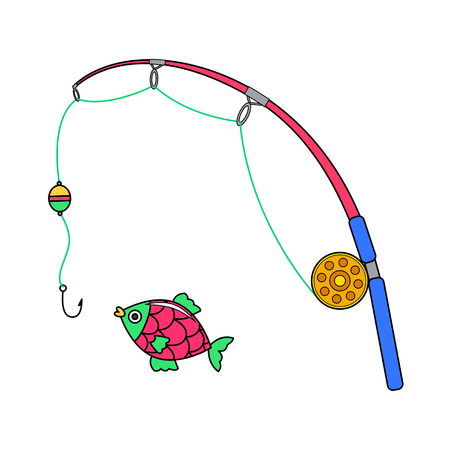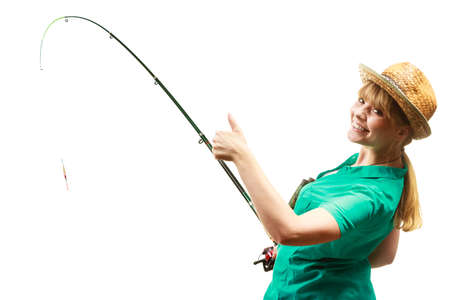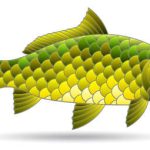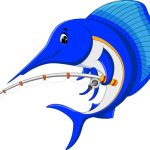1. Rod and Reel Selection
When it comes to spring fishing, picking the right rod and reel combo can make all the difference. Early season conditions often mean colder water temperatures, which directly affect fish behavior. Species like bass, trout, and walleye tend to be less aggressive in early spring, so your gear needs to match their mood.
Spinning vs. Baitcasting: Whats Best for Spring?
Both spinning and baitcasting setups have their place in early spring fishing. Heres a quick breakdown to help you choose the right one:
| Type | Best For | Pros | Cons |
|---|---|---|---|
| Spinning Combo | Trout, finesse bass fishing | Easy to use, great for light lures and lines | Less control with heavier baits or windy conditions |
| Baitcasting Combo | Bass, walleye with heavier lures | Better accuracy and power for larger fish | Takes more practice, prone to backlashes if mishandled |
Rod Power and Action Matter
In cold water, fish tend to strike lightly. A rod with medium-light to medium power and fast action helps detect subtle bites while still offering enough backbone to handle a fight. Here’s a general guide:
| Species | Recommended Rod Power | Recommended Action |
|---|---|---|
| Bass (early spring) | Medium | Fast |
| Trout | Light to Medium-Light | Moderate to Fast |
| Walleye | Medium-Light to Medium | Fast |
Don’t Forget the Reel Specs
Your reel should match the rod in size and balance. For spinning reels, sizes 1000–2500 work well for trout and finesse fishing, while sizes 3000–4000 are ideal for bass and walleye. For baitcasters, low-profile reels with a smooth drag system are perfect for targeting bass with jigs or crankbaits.
A Quick Tip:
If youre unsure what species youll run into on your trip, go with a versatile medium power rod paired with a size 2500 spinning reel. Its a solid all-around setup that handles most early spring scenarios.
Selecting the right rod and reel not only improves your casting accuracy but also boosts your chances of landing more fish in those chilly early months.
2. Line and Tackle Essentials
When it comes to spring fishing, having the right line and tackle can make all the difference. As waters begin to warm and clarity improves, you’ll want gear that helps you stay stealthy while still being strong enough to handle aggressive early-season fish.
Choosing the Right Fishing Line
Spring fishing often means clearer water and more vegetation starting to grow back. That’s why picking the right line is important for both visibility and strength. Here are two popular choices:
| Line Type | Best Use | Advantages |
|---|---|---|
| Fluorocarbon | Clear water & finesse presentations | Low visibility underwater, good sensitivity, sinks well for bottom contact baits |
| Braided Line | Heavy cover & power fishing | High strength-to-diameter ratio, no stretch, ideal for thick grass or wood cover |
A good combo many anglers use is a braided mainline with a fluorocarbon leader—giving you strength and stealth in one setup.
Go-To Spring Tackle Options
In early spring, fish can be sluggish one day and active the next. Having a variety of lures lets you adjust quickly based on how the fish are reacting. Here are some must-have tackle options:
Jigs
A cold-water favorite, jigs imitate crawfish or baitfish depending on how you rig them. Great for slow dragging along bottom structure where bass tend to hang out early in the season.
Crankbaits
Lipless or shallow-running crankbaits work well when fish start moving up into warmer shallows. Choose natural colors like red or craw-patterns during early spring.
Swimbaits
Paddle-tail swimbaits mimic baitfish and are perfect for slow rolling through open water or around structure. Soft plastics on a jig head are super versatile this time of year.
Spinnerbaits
If water is stained or windy conditions roll in, spinnerbaits shine. The flash and vibration help fish locate your lure even when visibility isn’t great.
The key with spring tackle is variety—have a mix of reaction baits and slower presentations to match whatever mood the fish are in that day. Keeping these essentials in your tackle box will help you be ready for anything spring throws at you.

3. Cold Weather Apparel and Gear
Early spring fishing often means chilly mornings, especially if youre heading out before sunrise. Staying warm and dry is key to enjoying your time on the water, so having the right cold weather gear is a must. Layering is your best friend—start with a moisture-wicking base layer, add an insulating mid-layer, and finish with a waterproof outer layer to block wind and rain.
Layering Essentials
| Item | Description |
|---|---|
| Base Layer | Lightweight, moisture-wicking fabric to keep sweat off your skin |
| Mid Layer | Fleece or insulated jacket for warmth |
| Outer Layer | Waterproof and windproof jacket and pants to protect from the elements |
Footwear and Hand Protection
Your feet and hands are especially vulnerable to cold temperatures. Insulated, waterproof boots help keep your feet dry when walking along wet banks or standing in shallow water. Pair them with thermal socks for extra warmth. Gloves designed for fishing allow you to stay warm while still handling your rod and tackle efficiently.
| Gear | Why You Need It |
|---|---|
| Insulated Boots | Keep feet warm and dry in wet or muddy conditions |
| Thermal Socks | Add extra insulation inside boots |
| Fishing Gloves | Provide warmth without sacrificing dexterity |
Extra Warmth Accessories
Dont forget about those small items that can make a big difference in comfort. Disposable hand warmers are great to keep in your pockets or gloves, especially during early morning hours when temperatures are at their lowest.
- Hand Warmers: Easy to use and last several hours—perfect for long outings.
- Knit Beanie or Hat: Helps retain body heat through your head.
Dressing smartly ensures that you stay focused on the fish—not the forecast. Proper clothing lets you stay out longer and enjoy every cast of your spring fishing trip.
4. Fishing Accessories and Tools
Having the right accessories and tools can make a big difference when youre out fishing during the spring season. These items might not be as flashy as rods or reels, but they’re essential for making your time on the water more productive and enjoyable. Heres a breakdown of must-have gear every early season angler should pack:
Polarized Sunglasses
Spring sunlight reflecting off the water can strain your eyes and make it tough to spot fish. Polarized sunglasses reduce glare, improve visibility below the surface, and protect your eyes from harmful UV rays. They’re a game-changer for sight fishing in clear spring waters.
Pliers and Multi-Tools
A good pair of needle-nose pliers is a must for removing hooks, cutting line, or making quick tackle adjustments. Multi-tools with scissors, screwdrivers, and line cutters are also incredibly handy, saving you time when small repairs or tweaks are needed.
Tackle Boxes and Organizers
Keeping your lures, hooks, weights, and other terminal tackle organized saves you frustration on the water. With spring fishing often involving quick changes in weather and fish behavior, youll want to access different baits fast. Look for waterproof tackle boxes with adjustable compartments for maximum flexibility.
| Accessory | Main Purpose | Why It’s Important in Spring |
|---|---|---|
| Polarized Sunglasses | Reduce glare and improve underwater visibility | Helps spot fish in clearer spring waters |
| Pliers/Multi-Tool | Hook removal, line cutting, tackle adjustments | Quick fixes during unpredictable spring conditions |
| Tackle Box | Keeps gear organized and accessible | Makes switching baits faster with changing patterns |
| Fish Finder | Locates fish using sonar technology | Saves time by identifying productive fishing spots early in the season when fish are scattered |
| Landing Net | Aids in safely landing fish without harm | Essential for catch-and-release efforts during spawning season |
Fish Finders
Springtime fish can be scattered as they move between deep winter holes and shallow spawning areas. A portable fish finder helps you locate schools faster so you spend more time catching and less time guessing. Many modern models are compact, GPS-enabled, and easy to use—even from a kayak or small boat.
Landing Nets
A quality landing net makes it easier to bring in your catch safely without losing it at the boat or bank. Rubber-coated nets are especially great because they minimize harm to the fish—important if youre practicing catch-and-release during spawning season.
Pro Tip:
Keep all your essential accessories easily accessible—either clipped to your vest or within arm’s reach on your boat—to avoid fumbling around when the action heats up.
Dont Overlook the Little Things!
The right tools not only make spring fishing smoother but also help you stay prepared for whatever surprises nature throws at you early in the season.
5. Safety and Boat Preparation
Before you launch your boat for the first spring trip, its crucial to make sure everything is ready for a safe and smooth day on the water. Early season fishing means unpredictable weather, cold water temps, and sometimes rough conditions — so safety should be just as important as your tackle box.
Boat Maintenance Checklist
Winter can be tough on boats, especially if theyve been sitting idle. Give your vessel a full check-up before heading out:
| Item | What to Check |
|---|---|
| Battery | Charge level, corrosion on terminals |
| Fuel System | Leaks, fuel quality, hose condition |
| Propeller | Dings or bends, secure connection |
| Bilge Pump | Functionality and clean pump area |
| Lights & Electronics | Test navigation lights, fish finders, radios |
Inspect Your Safety Gear
Your fishing adventure isnt complete without proper safety equipment. Heres what you should double-check:
- Life Jackets: Make sure theres one U.S. Coast Guard-approved life vest per person — and that they’re in good condition.
- Throwable Flotation Device: Required on most boats; check for wear or damage.
- Fire Extinguisher: Ensure it’s fully charged and not expired.
- First Aid Kit: Stock with essentials like bandages, antiseptic, and seasickness meds.
- Sound-Producing Devices: A whistle or horn is often required by law.
Know the Rules Before You Go
Laws can change from season to season. Be sure to review local and state fishing regulations for the body of water youre visiting. This includes limits on species, size restrictions, licensing rules, and any seasonal closures.
Prepare for Spring Weather Conditions
The weather can shift quickly in spring — sunny skies can turn into a chilly rainstorm fast. Dress in layers and pack waterproof clothing just in case. Also consider bringing an emergency blanket or dry bag with extra clothes. Hypothermia is a real risk in early spring water temps.
Weather Prep Essentials:
- Layered clothing (base layer, fleece, waterproof outer)
- Rain gear (jacket and pants)
- Sunscreen and polarized sunglasses
- Dry bag with spare socks and gloves
- Check marine forecast before departure
A little preparation goes a long way in making your spring fishing trips both fun and safe.


